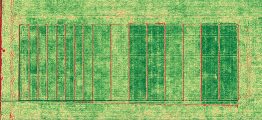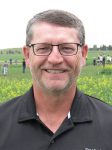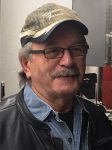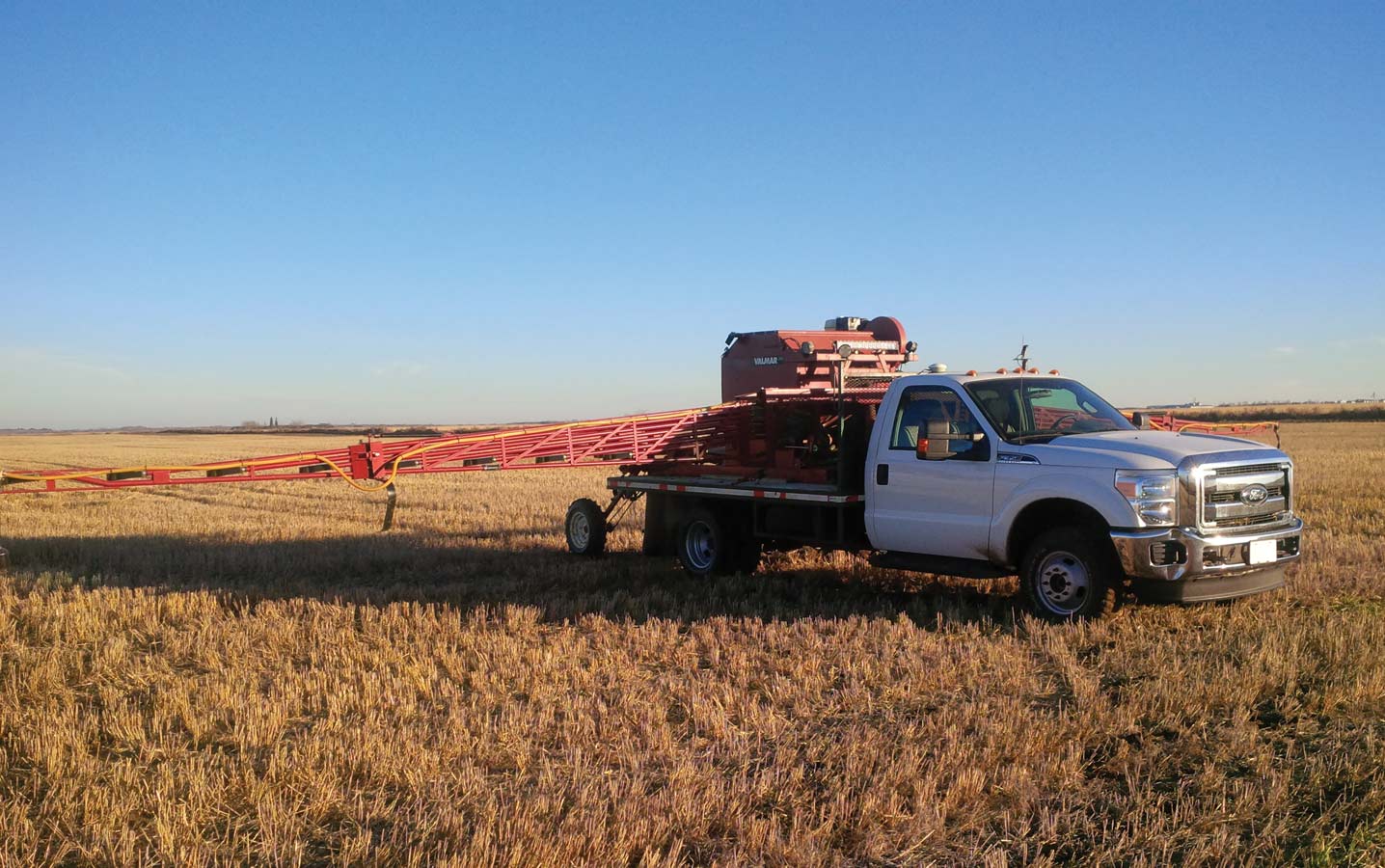Bending tech
Landon Friesen
Crystal City, Man.
“I want to compare these images with yield maps to see the correlation between plant stand and yield.”
 Landon Friesen has software so his drone camera can do plant stand counts and read elevation. His drone is a DJI Phantom 4 quad-copter, an upgrade from his original Phantom 2, but still a relatively inexpensive model “you can buy at Staples.” With automated flight software, Friesen enters coordinates of the field or area to image and the drone takes off and does the job. No piloting required.
Landon Friesen has software so his drone camera can do plant stand counts and read elevation. His drone is a DJI Phantom 4 quad-copter, an upgrade from his original Phantom 2, but still a relatively inexpensive model “you can buy at Staples.” With automated flight software, Friesen enters coordinates of the field or area to image and the drone takes off and does the job. No piloting required.
He tried the plant stand count program on one quarter of canola in 2016. “We then went back and ground-truthed a few areas for accuracy and it was bang on,” he says. “I’m excited to try it again in 2017. I want to compare these images with yield maps to see the correlation between plant stand and yield.” He plans to put in replicated strips for various seeding rates. He’ll use the drone to image growth patterns all season long.
Friesen used the elevation feature to create 3D images of yard sites. His brother, Derek, needed a land survey for a house he’s building. It was going to cost $2,500 to have a surveyor do it. Instead, they took a 3D image with the drone and marked it up to show the footprint of the planned house, distance to the existing sewer and other measurements required. “We emailed it to the engineer and he approved it,” Friesen says.

They also put up a new row of bins that needed three-phase power. They sent Manitoba Hydro a detailed landscape image showing distance from the power source to the bins so utility staff knew the required measurements before coming to the site.
When making crop insurance claims for flooded acres in 2016, Friesen provided an elevation-based image of the field showing low spots and lost acres calculated at 25.34 acres for one field and 215 acres for the whole farm. “We printed off the maps, mailed them to Crop Insurance, and they accepted them,” he says.
To give one more example of the utility of 3D images, they can also provide an instant estimate of cubic yards within a gravel pile, he says.
Friesen buys his drone software online at dronedeploy.com.
Dale Fedoruk
Red Deer, Alta.
 Dale Fedoruk sees new life for two older technologies – Valmar applicator and granular herbicides. A Valmar mounted on a modern comfortable truck with new tech upgrades for guidance and night application has become an important weed management tool for the farmer and independent crop production advisor from Red Deer.
Dale Fedoruk sees new life for two older technologies – Valmar applicator and granular herbicides. A Valmar mounted on a modern comfortable truck with new tech upgrades for guidance and night application has become an important weed management tool for the farmer and independent crop production advisor from Red Deer.
Fedoruk has a Trimble CFX-750 controller and light-bar for guidance as well as foam markers for back up. “If I ever lose a GPS signal, the foam marker allows me to keep working,” he says. Foam also provides added help in fields with a lot of curves, bush and wet spots.
Because granular herbicides have the “consistency of dust,” wind is a bigger factor with the Valmar that it is with a pressure-powered sprayer. For this reason, he has high-powered flood lights and a system of cameras for applications at night. “Well over 50 per cent of my work with the Valmar is done in the evening when the wind slows down,” he says. Infrared cameras inside the tank and on the metering wheel, metering clutch and pressure gauge allow him to monitor machine function in the dark.
The revival in granular herbicides is driven by herbicide-resistant weeds, including wild oats, cleavers and kochia, but also general increases in millet, barnyard grass, chickweed, lamb’s-quarters and hemp nettle. Fedoruk applies Edge, trifluralin, Avadex and Fortress, with Edge being the most popular.
“Granular herbicides went out of favour in the ‘90s with herbicide-tolerant canola and the launch of more convenient and improved post-emergence herbicides,” Fedoruk says. But these days, he sees very good use for fall-applied products in a no-till or minimum-till system. “With surface- applied granular pre-emergent herbicides they do an excellent job of controlling shallow germinating weeds, as long as we have sufficient moisture.”
Ed Keyowski
Hamton, Sask.
 Ed Keyowski is a draftsman by trade and likes tinkering in the shop. “I always have to be doing something to make tools better,” he says. “I like the satisfaction of making something work, and I don’t care how long it takes. I make a lot of mistakes along the way, but I stay positive.”
Ed Keyowski is a draftsman by trade and likes tinkering in the shop. “I always have to be doing something to make tools better,” he says. “I like the satisfaction of making something work, and I don’t care how long it takes. I make a lot of mistakes along the way, but I stay positive.”
Twenty-five years ago, when he bought his first airseeder, he built his own stand to keep the grain-tank hitch out of the mud. And because he farmed alone at the time, he wanted something to help back up the truck to the airseeder auger. So he made a sensor for the back of the truck that would alert him when he was in position. “Originally, I set it up so a light would go on in the cab, but then I thought, ‘What if the bulb is burnt out? I’ll have a bent auger’,” he says. So he reversed it. The light turned on when he activated the sensor, then went off when he was in position.
“I always have to be doing something to make tools better. I like the satisfaction of making something work, and I don’t care how long it takes.”
“Eighteen years later, I’m at the Farm Progress Show in Regina and a guy is selling this very thing,” Keyowski says. “He probably made a million and retired.”
This winter, Keyowski and his son Garrett will update their MacDon split-reel combine header so canola doesn’t bunch up when straight cutting. The Keyowskis have 35-foot MacDon headers on both combines — one is a straight reel, one is split. The swather has a similar split-reel heavy duty header and Keyowski likes being able to off-set the reels so one bat hits the knife about 10” before the other, which, he believes, creates a better windrow. “Improved flow from these swaths may be minute, but it makes a difference at the end of the day,” he says.
But when using a split-reel header for straight cutting, he found that in the afternoons when combining should be ideal, canola plants would catch on the middle arms of the reel. “As soon as one plant catches, crop bunches up quickly,” he says. He has a couple of ideas to improve the header, but he doesn’t want to share until he has a chance to try them. He suggests that Canola Digest check in with him next year for an update.
The Keyowski farm has straight cut canaryseed, wheat and oats for decades, they straight cut soybeans and have straight cut part of their canola crop for the past eight years. It has worked so well to improve canola yields, speed up harvest and reduce losses, that he expects the swather “won’t be moving out of the shed” in 2017.





